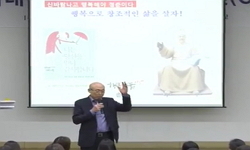간경도감의 언해불전은 그동안 국어학·서지학 분야에서 많은 연구가 이루어져 왔고, 국사학?불교학계에서는 간행의 이유 및 목적에 대한 논의가 있었다. 이들 논의는 간경도감본 언해불전�...
http://chineseinput.net/에서 pinyin(병음)방식으로 중국어를 변환할 수 있습니다.
변환된 중국어를 복사하여 사용하시면 됩니다.
- 中文 을 입력하시려면 zhongwen을 입력하시고 space를누르시면됩니다.
- 北京 을 입력하시려면 beijing을 입력하시고 space를 누르시면 됩니다.
https://www.riss.kr/link?id=A60073102
- 저자
- 발행기관
- 학술지명
- 권호사항
-
발행연도
2012
-
작성언어
Korean
- 주제어
-
등재정보
KCI등재
-
자료형태
학술저널
-
수록면
95-122(28쪽)
- 제공처
-
0
상세조회 -
0
다운로드
부가정보
국문 초록 (Abstract)
이에 본고는 15세기 불전언해의 시대적 맥락과 그 의미를 파악하기 위한 작업의 일환으로, 선행연구와는 다른 측면에서 언해불전의 간행 이유와 그 성격에 대해 살펴보았다. 이를 위해 세조대의 주요 불교 정책과 간경도감본 언해불전의 내용 및 성격을 검토하였고, 이상의 검토 결과를 세종대의 불서 편찬의 의도와 관련지어 살펴보았다. 그 결과, 간경도감의 언해불전은 세종의 불교 순화 정책, 곧 백성의 교화와 승려의 교육이라는 두 가지 지향을 계승한 것으로, 儒臣 중심의 간경도감 운영 및 언해 주도와, 불교의 기본 경전을 중심으로 한 언해 텍스트의 선정, 그리고 원문 대역의 번역 방식 등의 특징은 이러한 의도를 반영한 것이라 할 수 있다.
결국, 세조대 언해불전의 편찬 및 간행은 불교 중흥 또는 불교대중화와는 그 성격이 다른, 국가의 안정과 통합을 위한 불교계에 대한 문화 통제의 성격을 갖는다고 하겠다.
간경도감의 언해불전은 그동안 국어학·서지학 분야에서 많은 연구가 이루어져 왔고, 국사학?불교학계에서는 간행의 이유 및 목적에 대한 논의가 있었다. 이들 논의는 간경도감본 언해불전의 편찬 및 간행을 세조의 왕권 확립 내지 강화의 의도로 보거나, 불교대중화와 불교의 사상적 중흥을 지향한 것으로 파악하고 있다. 그러나 ‘억불숭유’의 시대적 흐름과 불전언해의 번역 양식 등을 고려해 볼 때 이러한 견해들은 의심의 여지가 있다.
이에 본고는 15세기 불전언해의 시대적 맥락과 그 의미를 파악하기 위한 작업의 일환으로, 선행연구와는 다른 측면에서 언해불전의 간행 이유와 그 성격에 대해 살펴보았다. 이를 위해 세조대의 주요 불교 정책과 간경도감본 언해불전의 내용 및 성격을 검토하였고, 이상의 검토 결과를 세종대의 불서 편찬의 의도와 관련지어 살펴보았다. 그 결과, 간경도감의 언해불전은 세종의 불교 순화 정책, 곧 백성의 교화와 승려의 교육이라는 두 가지 지향을 계승한 것으로, 儒臣 중심의 간경도감 운영 및 언해 주도와, 불교의 기본 경전을 중심으로 한 언해 텍스트의 선정, 그리고 원문 대역의 번역 방식 등의 특징은 이러한 의도를 반영한 것이라 할 수 있다.
결국, 세조대 언해불전의 편찬 및 간행은 불교 중흥 또는 불교대중화와는 그 성격이 다른, 국가의 안정과 통합을 위한 불교계에 대한 문화 통제의 성격을 갖는다고 하겠다.
다국어 초록 (Multilingual Abstract)
Thus, different from previous studies, this study examined the purposes and nature of Korean-version Buddhist texts published by Gangyeongdogam as one of efforts to understand the historical context and meanings of Korean version Buddhist texts in the 15th century. For this purpose, we analyzed major Buddhism related policies during the reign of King Sejo and the contents and nature of Korean version Buddhist texts published by Gangyeongdogam during the period, and discussed the results in connection to the intention of Buddhist text compilation during the reign of King Sejong. According to the results, the publishing of Korean-version Buddhist texts by Gangyeongdogam inherited King Sejong’s Buddhism refinement policies, namely, the edification of people and the education of monks. This intention was reflected in the characteristics such as the operation and translation of Gangyeongdogam led by Confucian officials, the selection of texts mainly from the basic Buddhist scriptures, and bilingual edition of the original language and the Korean language.
In conclusion, the compilation and publishing of Korean-version Buddhist texts in the reign of King Sejo were more for cultural control over the Buddhist circle for the stability and integration of the state than for the revival and popularization of Buddhism.
Korean-version Buddhist texts published by Gangyeongdogam (government office for publishing Korean-version Buddhist texts) have been studied mostly in the areas of Korean language and bibliography, and previous studies by the academic circles of Korea...
Korean-version Buddhist texts published by Gangyeongdogam (government office for publishing Korean-version Buddhist texts) have been studied mostly in the areas of Korean language and bibliography, and previous studies by the academic circles of Korean history and Buddhist studies have discussed the reasons and purposes of such publications. These discussions viewed that the compilation and publishing of Korean-version Buddhist texts by Gangyeongdogam purposed to establish or reinforce King Sejo"s sovereign power or to popularize Buddhism and revive Buddhist thoughts. Considering the historical trend suppressing Buddhism and advocating Confucianism and the translation style of Koreanversion Buddhist texts, however, these views are somewhat questionable.
Thus, different from previous studies, this study examined the purposes and nature of Korean-version Buddhist texts published by Gangyeongdogam as one of efforts to understand the historical context and meanings of Korean version Buddhist texts in the 15th century. For this purpose, we analyzed major Buddhism related policies during the reign of King Sejo and the contents and nature of Korean version Buddhist texts published by Gangyeongdogam during the period, and discussed the results in connection to the intention of Buddhist text compilation during the reign of King Sejong. According to the results, the publishing of Korean-version Buddhist texts by Gangyeongdogam inherited King Sejong’s Buddhism refinement policies, namely, the edification of people and the education of monks. This intention was reflected in the characteristics such as the operation and translation of Gangyeongdogam led by Confucian officials, the selection of texts mainly from the basic Buddhist scriptures, and bilingual edition of the original language and the Korean language.
In conclusion, the compilation and publishing of Korean-version Buddhist texts in the reign of King Sejo were more for cultural control over the Buddhist circle for the stability and integration of the state than for the revival and popularization of Buddhism.
목차 (Table of Contents)
- 국문초록
- 1. 문제 제기
- 2. 세조대의 불교 정책과 간경도감의 설치
- 3. 간경도감 간행 불전의 내용과 성격
- 4. 불전언해의 시대적 맥락과 의미
- 국문초록
- 1. 문제 제기
- 2. 세조대의 불교 정책과 간경도감의 설치
- 3. 간경도감 간행 불전의 내용과 성격
- 4. 불전언해의 시대적 맥락과 의미
- Abstract
- 참고문헌
동일학술지(권/호) 다른 논문
-
- 동악어문학회
- 배연형(Bae, Yeon Hyung)
- 2012
- KCI등재
-
- 동악어문학회
- 윤인숙(Yun, In Sook)
- 2012
- KCI등재
-
- 동악어문학회
- 홍선미(Hong, Sun Mi)
- 2012
- KCI등재
-
조선전기 두시(杜詩) 이해의 지평과 『두시언해(杜詩諺解)』 간행의 문학사적 의미
- 동악어문학회
- 김남이(Kim, Nam Yi)
- 2012
- KCI등재





 DBpia
DBpia






